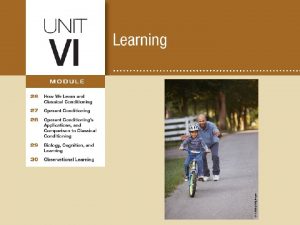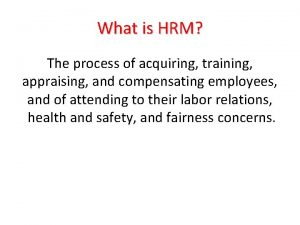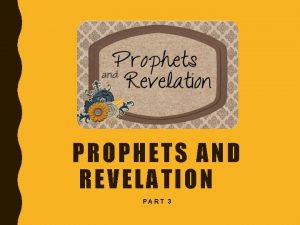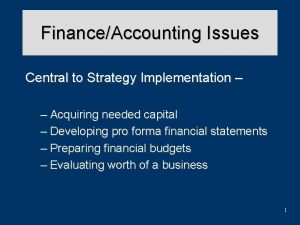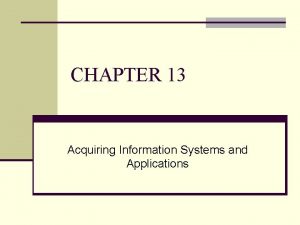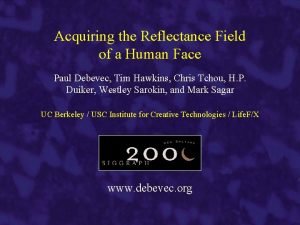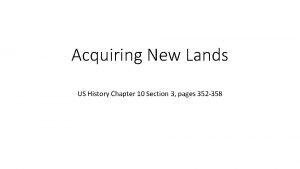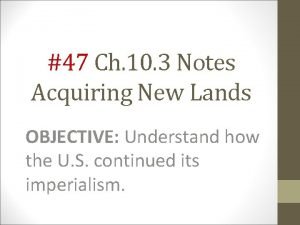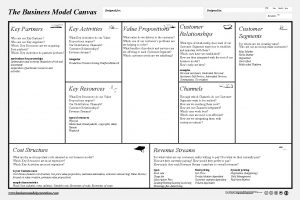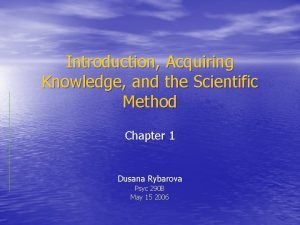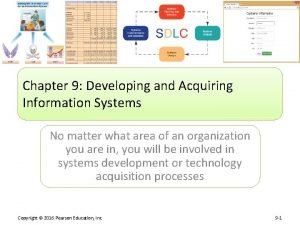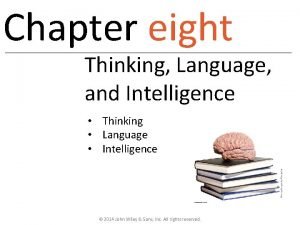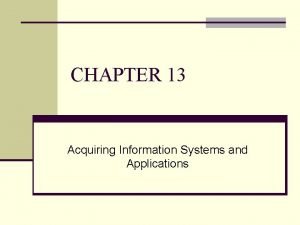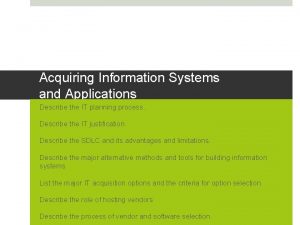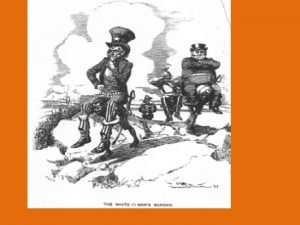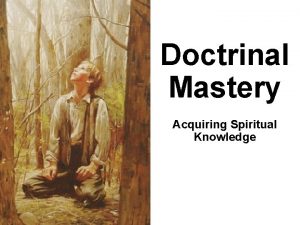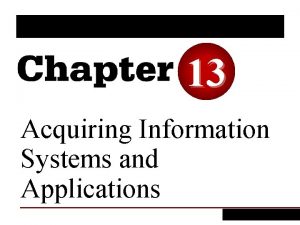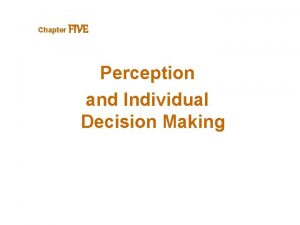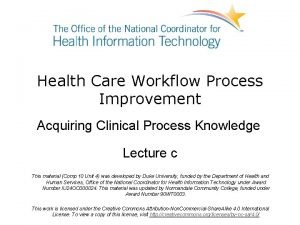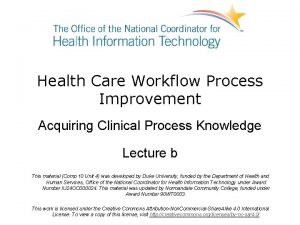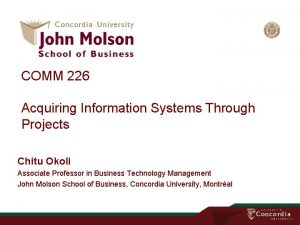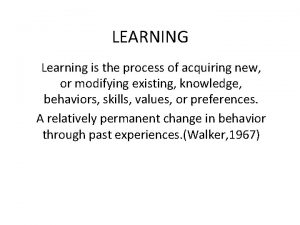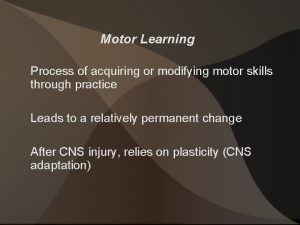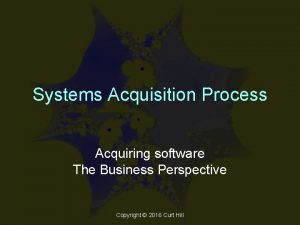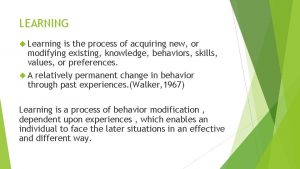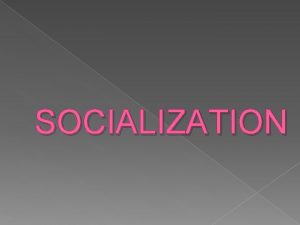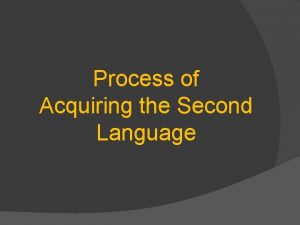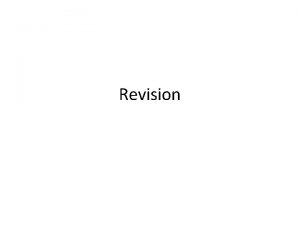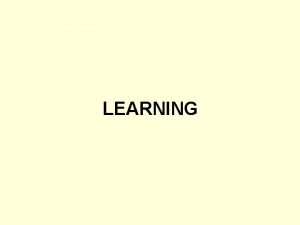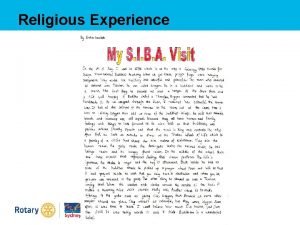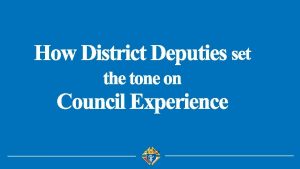What is the process of acquiring through experience




























































- Slides: 60


What is ______? the process of acquiring through experience new and relatively enduring information or behaviors The emphasis here is on enduring…learning is very different from cramming. To truly learn, is to own the knowledge, skill or idea.

What are some ways we learn? We learn to expect and prepare for significant events such as food or pain (_____conditioning). We learn to repeat acts that bring rewards and avoid acts that bring unwanted results (_____ conditioning). We learn by observing events and people (_______learning). We learn things we have neither experienced or observed (_______ learning).

What are two types of associative learning? ____conditioning _____ conditioning In classical conditioning, we learn to associate two stimuli and thus to anticipate events. Stimuli are things we do not control and that we respond automatically (involuntary responses). In operant conditioning, we learn to associate a response (our behavior) and its consequence. The behavior is voluntary, we operate on the environment to produce a consequence.

What is the difference between habituation and sensory adaptation? ______ adaptation _____ is a type of learning or relatively permanent change in behavior that involves a reduced response as a result of repeated but not constant exposure. _____ adaption is a perceptual phenomenon that occurs when the brain stops recognizing a constant and unchanging stimulus.

What is a ____? any event or situation that evokes a response So… for the sea slug…the stimulus was the squirt from the choppy ocean waters or the electric shock from the researcher. For the popcorn eater…the stimulus was the movie theater environment.

What is a _____? the behavior that follows the stimulus For the sea slug…the involuntary behavior (classical conditioning) was the shirking. For the popcorn eater…the voluntary behavior was the purchasing and eating of popcorn.

How is __________defined? ______conditioning is a type of associative learning that involves learned involuntary responses. We associate stimuli that we do not control, and we respond automatically (exhibiting respondent behavior). Involuntary responses include salivation, blinking, sweating, and cringing or the automatic bodily reactions to strong emotions such as fear.

How is_____conditioning defined? we learn to associate a response (our voluntary behavior) and its consequence Thus we (and other animals) learn to repeat voluntary acts followed by good results and avoid voluntary acts followed by bad results. These associations produce operant behaviors (which operate on the environment to produce a consequence).

How does ____conditioning occur? We learn that a voluntary behavior or response of politeness, for example, is associated with the consequence of receiving a cookie.

What are respondent behaviors and what are operant behaviors? _____ behaviors ______ behaviors behavior that occurs as an automatic response to some stimulus behavior that operates on the environment, producing consequences …like the woman tensing for the thunder boom …like the boy saying ‘please’

What did _________contribute to the field of psychology? Pavlov spent two decades studying dogs’ digestive system and earned the Nobel Prize. Ivan Pavlov (1849 -1936) His experiments on learning produced the phenomenon we call _____conditioning.

What are the components of _____ conditioning?

How are the unconditioned ____ (US) and unconditioned _____ (UR) related? Food in the mouth automatically, unconditionally, triggers a dog’s salivary reflex. No training is required for this automatic involuntary response. Pavlov called this reflex an unconditioned response (UR). He called the food an unconditioned stimulus (US).

What is the _______ stimulus (NS)? The tone or bell when activated produces no response. Pavlov called the bell/tuning fork/buzzer the neutral stimulus (NS).

What happens in a conditioning trial? Pavlov conducted multiple trials pairing the neutral stimulus (NS) of the tone with the US of the food. The unconditioned stimulus (US) of the food, though is what continues to produce the unconditioned response (UR) of the drool/salivation.

What are the _______ response (CR) and ______ stimulus (CS)? Salivation in response to a tone, however, is learned. It is conditional upon the dog’s associating the tone with the food. This response is the conditioned response (CR). The neutral stimulus (NS) that now triggers salivation is the conditioned stimulus (CS).

What is _______? …in classical conditioning, the initial stage, when one links a neutral stimulus and an unconditioned stimulus so that the neutral stimulus begins triggering the conditioned involuntary response …in operant conditioning, the strengthening of a reinforced response or the decreasing of a punished response

What is ______-order conditioning? a procedure in classical conditioning in which the conditioned stimulus in one conditioning experience is paired with a new neutral stimulus, creating a second (often weaker) conditioned stimulus For example, an animal that has learned that a tone predicts food might then learn that a light predicts the tone and begin responding to the light alone. (Also called second-order conditioning. )

How does _____ occur? when an unconditioned stimulus (US) does not follow a conditioned stimulus (CS) So, in this case, when food no longer follows the bell.

What is ______ recovery? the reappearance, after a pause, of an extinguished conditioned response

What is _____? the tendency, once a response has been conditioned, for stimuli similar to the conditioned stimulus to elicit similar responses So… if Pavlov’s dog learned to salivate to a tone, and the researcher then rang a bell, or played a note on a flute, it may be that the dog drools to those stimuli as well. We would say the dog had generalized his response to the stimulus.

What is ______? the learned ability to distinguish between a conditioned stimulus and similar stimuli that do not signal an unconditioned stimulus So if Pavlov only presented the food (US) after the bell (CS) but not the tone, tuning fork, or buzzer, the dog would learn to discriminate between the sounds and only drool (CR) to the bell.

What did ______ and Rayner do? _____ __ ______and his graduate assistant Rosalie Rayner conditioned “Little Albert” to fear a white rat after repeatedly experiencing a loud noise as the rat was presented.

What is _____ conditioning? a type of learning in which a behavior becomes more likely to recur if followed by a reinforcer or less likely to recur if followed by a punisher

Who was ____? B. F. Skinner (1904 -1990) Skinner was behaviorism’s most influential and controversial figure. His work elaborated on what psychologist Edward L. Thorndike called the _____ of ______.

What is the ____ __ ______? Thorndike’s principle that behaviors followed by favorable consequences become more likely, and that behaviors followed by unfavorable consequences become less likely. The cats’ performance tended to improve with successive trials, illustrating Thorndike’s law of effect.

What did Skinner design? For his pioneering studies on operant conditioning, Skinner designed an _____chamber, popularly known as a _______ box.

What is an _____ chamber? in operant conditioning research, a chamber (also known as a Skinner box) containing a bar or key that an animal can manipulate to obtain a food or water reinforcer; attached devices record the animal’s rate of bar pressing or key pecking

What makes a reinforcer a _____? It is important to note that a reinforcer is defined by its impact on behavior. A reinforcer increases the likelihood that the behavior will increase. Ice cream may sound like it is a reinforcer for all, but what if the subject is lactose intolerant?

How is behavior shaped through operant conditioning? _____ is an operant conditioning procedure in which reinforcement guides behavior toward closer and closer approximations of the desired behavior. This is also called reward by successive approximations.

What is a _______ stimulus? a stimulus that elicits a response after association with reinforcement (in contrast to related stimuli not associated with reinforcement) So, Skinner may train a pigeon to peck at a green circle (the discriminative stimulus), but not a red square.

What is _____reinforcement? increasing behaviors by presenting positive reinforcers A positive reinforcement is any stimulus that, when presented after a response, strengthens the response.

What is_____reinforcement? increasing behaviors by stopping or reducing aversive stimuli A negative reinforcement is any stimulus that, when removed after a response, strengthens the response.

What are ____ and conditioned (_____) reinforcers? _____ reinforcers innately reinforcing stimuli such as those that satisfy a biological need examples: food, pain relief conditioned (______) reinforcers stimuli that gain their reinforcing power through their learned association with a primary reinforcer examples: money, good grades, a pleasant tone of voice

What are reinforcement ______? Reinforcement schedules are patterns that define how often a desired response will be reinforced. Two types of reinforcement schedules are: _____reinforcemen t schedule _____(intermittent) reinforcement schedule reinforcing the desired response every time it occurs reinforcing a response only part of the time

How does _____ reinforcement impact learning? With continuous reinforcement, learning occurs rapidly, so its the best choice for learning a behavior. Extinction also occurs rapidly. When continuous reinforcement stops, the behavior soon stops (is extinguished). If a normally dependable candy machine fails to deliver a chocolate bar twice in a row, we stop putting money into it (although a week later we may exhibit spontaneous recovery by trying again).

How does _____ (intermittent) reinforcement impact learning? Real life rarely provides continuous reinforcement. Salespeople do not make a sale with every pitch. But they persist because their efforts are occasionally rewarded. This persistence is typical with partial (intermittent) reinforcement schedules, in which responses are sometimes reinforced, sometimes not. Learning is slower to appear, but resistance to extinction is greater than with continuous reinforcement.

What are the four types of partial reinforcement? ______ratio schedules: reinforcement occurs after a set number of responses ____ interval schedules: reinforcement occurs after a set length of time _____ ratio schedules: reinforcement occurs after an unpredictable number of responses _____interval schedules: reinforcement occurs after an unpredictable length of time

What is_______and how is it different from negative reinforcement? Punishment is an event that tends to decrease the behavior it follows. Behavior that is punished is less likely to occur again. Punishment adds an aversive stimulus or removes a pleasant stimulus. Negative reinforcement increases the likelihood that the behavior will occur again. Negative reinforcement removes an aversive stimulus. Punishment tells you what not to do; reinforcement tells you what to do.

What are two ways to punish unwanted behavior? Positive punishment adds something negative. Negative punishment takes away something positive.

What is _________? Biofeedback systems—such as this one, which records tension in the forehead muscle of a headache sufferer—allow people to monitor their subtle physiological responses.

How are classical and operant conditioning similar and different? Both classical conditioning and operant conditioning are forms of associative learning.

Who was _______? John Garcia was among those who challenged the prevailing idea that all associations can be learned equally well. John Garcia (1917 -2012)

What were two findings in Garcia and Koelling’s study? First, even if sickened as late as several hours after tasting a particular novel flavor, the rats thereafter avoided that flavor. Second, the sickened rats developed conditioned aversions to tastes but not to sights or sounds. This made adaptive sense. For rats, the easiest way to identify tainted food is to taste it; if sickened after sampling a new food, they thereafter avoid it. This response is called __________.

______ aversion If you became violently ill after eating oysters, you would probably have a hard time eating them again. Their smell and taste would have become a CS for nausea. This learning occurs readily because our biology prepares us to learn taste aversions to toxic foods.

How do _____ processes affect classical conditioning? In their dismissal of “mentalistic” concepts such as consciousness, Pavlov and Watson underestimated the importance of the effects of cognitive processes (thoughts, perceptions, expectations).

What did _____ and Wagner show? Robert Rescorla and Allan Wagner (1972) showed that an animal can learn the predictability of an event. The more predictable the association, the stronger the conditioned response. It’s as if the animal learns an expectancy, an awareness of how likely it is that the US will occur.

What is a ____? a mental representation of the layout of one’s environment For example, after exploring a maze, rats act as if they have learned a cognitive map of it.

What is ______ learning? learning that occurs but is not apparent until there is an incentive to demonstrate it.

What is _____ learning? a sudden realization of a problem’s solution; contrasts with strategy-based solutions

What is the difference between extrinsic and intrinsic motivation to learn? ____ motivation _____ motivation a desire to perform a behavior to receive promised rewards or avoid threatened punishment a desire to perform a behavior effectively for its own sake

How does the cognitive perspective show us the limits of rewards? Promising people a reward for a task they already enjoy can backfire. This is called the ______effect. Excessive rewards can destroy intrinsic motivation —the desire to perform a behavior effectively and for its own sake.

What is ____ helplessness? the hopelessness and passive resignation an animal or person acquires when unable to avoid repeated aversive events

What research has been conducted on learned helplessness? In experiments, dogs were strapped in a harness and given repeated shocks, with no opportunity to avoid them. Later, when placed in another situation where they could escape the punishment by simply leaping a hurdle, the dogs displayed ____helplessness; they cowered as if without hope. Other dogs that had been able to escape the first shocks reacted differently. They had learned they were in control and easily escaped the shocks in the new situation. (Seligman & Maier, 1967)

Julian Rotter’s loci of control ____ locus of control _____ locus of control the perception that chance or outside forces beyond our personal direction determine our fate the perception that we direct and create our own fate

What is _____ learning? Higher animals, especially humans, learn without direct experience, by watching and imitating others. We learn our native languages and various other specific behaviors by observing and imitating others, a process called ______. For instance, a child who sees his sister burn her fingers on a hot stove learns not to touch it.

Who is Albert _____? Albert _____, shown here receiving a 2016 U. S. National Medal of Science from President Obama, is the pioneering researcher of observational learning.

What is the take away? By watching models, we experience _____ reinforcement or _____ punishment, and we learn to anticipate a behavior’s consequences in situations like those we are observing. We are especially likely to learn from people we perceive as similar to ourselves, as successful, or as admirable.

So we learn by observation, but how? _________ are frontal lobe neurons that some scientists believe fire when we perform certain actions or observe another’s actions. The brain’s mirroring of another’s action may enable imitation and empathy.
 Acquiring experience
Acquiring experience Process of acquiring training appraising and compensating
Process of acquiring training appraising and compensating Experience expectant vs experience dependent
Experience expectant vs experience dependent Early experience vs later experience debate
Early experience vs later experience debate Direct experience and indirect experience
Direct experience and indirect experience Customer relationship of business model canvas
Customer relationship of business model canvas Acquiring spiritual knowledge part 1
Acquiring spiritual knowledge part 1 Acquiring capital to implement strategies
Acquiring capital to implement strategies Strategies for acquiring it applications
Strategies for acquiring it applications Acquiring the reflectance field of a human face
Acquiring the reflectance field of a human face Acquire spiritual knowledge
Acquire spiritual knowledge Chapter 10 section 3 acquiring new lands
Chapter 10 section 3 acquiring new lands Acquiring new lands section 3
Acquiring new lands section 3 Business model canvas tripadvisor
Business model canvas tripadvisor Ways of acquiring knowledge
Ways of acquiring knowledge Acquiring information systems
Acquiring information systems 1. the ability to produce valued outcomes in a novel way
1. the ability to produce valued outcomes in a novel way Means acquiring goods and or services
Means acquiring goods and or services Acquiring information systems and applications
Acquiring information systems and applications Methods of acquiring information
Methods of acquiring information What factors did you consider in acquiring territories?
What factors did you consider in acquiring territories? Learning means acquiring
Learning means acquiring Doctrinal mastery
Doctrinal mastery Acquiring information systems and applications
Acquiring information systems and applications Through one man
Through one man Furcation involvement classification
Furcation involvement classification Through and through sawing advantages
Through and through sawing advantages I remember the night my mother was stung by a scorpion
I remember the night my mother was stung by a scorpion Is an unconscious process created from distilled experience
Is an unconscious process created from distilled experience Hát kết hợp bộ gõ cơ thể
Hát kết hợp bộ gõ cơ thể Slidetodoc
Slidetodoc Bổ thể
Bổ thể Tỉ lệ cơ thể trẻ em
Tỉ lệ cơ thể trẻ em Voi kéo gỗ như thế nào
Voi kéo gỗ như thế nào Thang điểm glasgow
Thang điểm glasgow Alleluia hat len nguoi oi
Alleluia hat len nguoi oi Các môn thể thao bắt đầu bằng tiếng đua
Các môn thể thao bắt đầu bằng tiếng đua Thế nào là hệ số cao nhất
Thế nào là hệ số cao nhất Các châu lục và đại dương trên thế giới
Các châu lục và đại dương trên thế giới Công thức tiính động năng
Công thức tiính động năng Trời xanh đây là của chúng ta thể thơ
Trời xanh đây là của chúng ta thể thơ Cách giải mật thư tọa độ
Cách giải mật thư tọa độ 101012 bằng
101012 bằng Phản ứng thế ankan
Phản ứng thế ankan Các châu lục và đại dương trên thế giới
Các châu lục và đại dương trên thế giới Thơ thất ngôn tứ tuyệt đường luật
Thơ thất ngôn tứ tuyệt đường luật Quá trình desamine hóa có thể tạo ra
Quá trình desamine hóa có thể tạo ra Một số thể thơ truyền thống
Một số thể thơ truyền thống Cái miệng xinh xinh thế chỉ nói điều hay thôi
Cái miệng xinh xinh thế chỉ nói điều hay thôi Vẽ hình chiếu vuông góc của vật thể sau
Vẽ hình chiếu vuông góc của vật thể sau Thế nào là sự mỏi cơ
Thế nào là sự mỏi cơ đặc điểm cơ thể của người tối cổ
đặc điểm cơ thể của người tối cổ Thế nào là giọng cùng tên?
Thế nào là giọng cùng tên? Vẽ hình chiếu đứng bằng cạnh của vật thể
Vẽ hình chiếu đứng bằng cạnh của vật thể Tia chieu sa te
Tia chieu sa te Thẻ vin
Thẻ vin đại từ thay thế
đại từ thay thế điện thế nghỉ
điện thế nghỉ Tư thế ngồi viết
Tư thế ngồi viết Diễn thế sinh thái là
Diễn thế sinh thái là Các loại đột biến cấu trúc nhiễm sắc thể
Các loại đột biến cấu trúc nhiễm sắc thể
